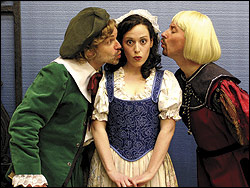A million dollars to anyone, other than the most devout Gilbert and Sullivan mavens, who can possibly identify the following: (1) Mr. Guizot; (2) Della Cruscan; (3) Sewell & Cross; (4) Paddington Pollaky; and (5) the Bishop of Sodor and Man.
They’re all mentioned—in passing, without explanation—in Patience (at the Seattle Repertory Theatre through Saturday, July 30; 206-341-9612), Gilbert’s most topical, most arcanely allusive libretto. It’s a send-up of the aesthetic movement— the Pre-Raphaelites, the decadents, the inner brotherhood, “art for art’s sake.” Any of this ringing a bell?
Oscar Wilde—surely you’ve heard of him, the most visible apostle of Aestheticism, and the ripest for parody? Victorian audiences would have been well aware of the stylized preciosities, pretensions, and excesses of Wilde’s ideas, his verse, and his followers. Though Gilbert didn’t directly base either of his male leads, Reginald Bunthorne (a fleshly poet) and Archibald Grosvenor (an idyllic poet), on Wilde, these characters are sometimes played as Wilde caricatures. In fact, it was partly to promote American performances of Patience that G&S impresario Richard D’Oyly Carte produced Wilde’s legendary American lecture tour, in which he preached his gospel of Beauty to Topeka and Dubuque.
But what do you do these days with the sort of libretto in which “Oh, South Kensington!” constitutes a punch line? (For perspective, imagine how an opera that joked about, say, grunge, Dale Chihuly, and single-tall mocha frappuccinos would play in London in 2130.) Well, you could update the book, and transpose the female chorus’ adulation of the two poets into some other more contemporary examples of celebrity worship—no doubt there were a few 1960s British stagings in which Bunthorne and Grosvenor were got up as John and Paul. Or you could just take Patience exactly as G&S left it, and accept the fact that no one in the audience is going to know what on earth the word “Daphnephoric” means.
This is how the Seattle Gilbert & Sullivan Society approaches this challenging period piece. Helpful program notes explain what all the fuss was about, but of the book itself they change scarcely a word. There’s no plot—the characters just fall in and out of love with one another for whatever silly reason until everyone decides to pair off in time for the finale.
Dave Ross—yes, that Dave Ross, talk-radio host and former 8th District Congressional candidate—is back for his 25th role with SGSS, and brilliant as usual as Bunthorne. The same goes for regulars Alyce Rogers (Lady Jane), adorable in the “heavy alto” parts that every G&S show includes, and William J. Darkow, who as Col. Calverley tosses off the hardest patter song in the canon. (Gilbert admits as much—”Take all the remarkable people in history/Rattle them off to a popular tune,” he writes, and the ensuing song is merely a list of proper names that would have spun the heads of even the most erudite listeners of 1881.) Cristina Villareale makes a vivacious company debut in the title role, a simple milkmaid who never succumbs to aesthetic absurdities, and John Brookes plays crisply off Ross as his rival Grosvenor. Bernie Kwiram’s pit orchestra sounded good and tight, and Nathan Rodda’s lovely turntable set would have pleased even Wilde.
But the true hero of this production is costume designer Carl Bronsdon, for clothing the men’s chorus of dragoons in impossibly bright shades of red and blue that must have given him headaches, as well as for not balking at a script that calls for a complete costume change for the entire women’s chorus just for the last six minutes of the show. Patience, indeed.







